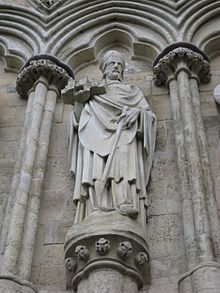Richard Poore
| Richard Poore | |
|---|---|
| Bishop of Durham | |

Sculpture on the west front of Salisbury Cathedral of Richard Poore, holding a model of the Cathedral in his hand.
|
|
| Appointed | 14 May 1228 |
| Term ended | 15 April 1237 |
| Predecessor | William Scot |
| Successor | Thomas de Melsonby |
| Other posts |
Bishop of Chichester Bishop of Salisbury Dean of Salisbury |
| Orders | |
| Consecration | 25 January 1215 |
| Personal details | |
| Died | 15 April 1237 Tarrant Keyneston, Dorset |
| Buried | probably church at Tarrant Keyneston, Dorset |
| Denomination | Catholic |
Richard Poore or Poor (died 15 April 1237) was a medieval English clergyman best known for his role in the establishment of modern Salisbury and its cathedral at their present location, away from the fortress at Old Sarum.
Poore was probably the son of Richard of Ilchester, also known as Richard Toclive, who served as Bishop of Winchester. He was the brother of Herbert Poore, who served as bishop of Salisbury from 1194 to 1217. Richard studied under Stephen Langton at Paris. Richard Poore became Dean of Salisbury in 1197, and unsuccessfully was nominated to the see of Winchester in 1205 and the see of Durham in 1213. His election to Durham was disallowed by Pope Innocent III before it was made public, probably because the pope knew that King John wished for the translation of his advisor John de Gray from the see of Norwich to Durham. During the interdict on England during King John's reign, Richard returned to Paris to teach until the interdict was lifted.
It was probably during these years before Poore held an episcopal office that he completed Osmund's Institutio, as well as his own works the Ordinale and the Consuetudinarium. The Institutio detailed the duties of the cathedral clergy at Salisbury, along with their rights. The Ordinale covered the liturgy, and how the various specialised services interacted with the basic divine service. The last work, the Consuetudinarium, gave the customs of Salisbury itself. Both the Consuetudinarium and the Ordinale were basically guides to the Sarum Rite, the usual form of liturgy in thirteenth century England. While he was dean, he also encouraged Robert of Flamborough to write a penitential.
...
Wikipedia
